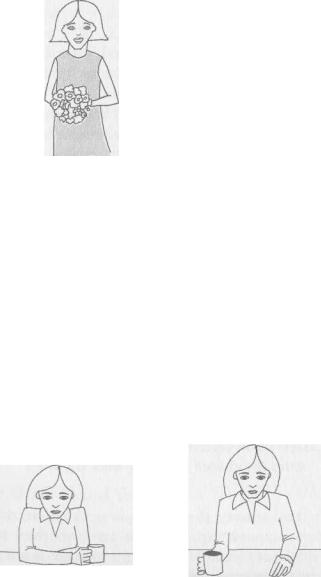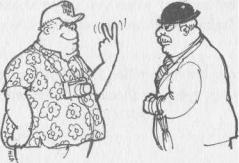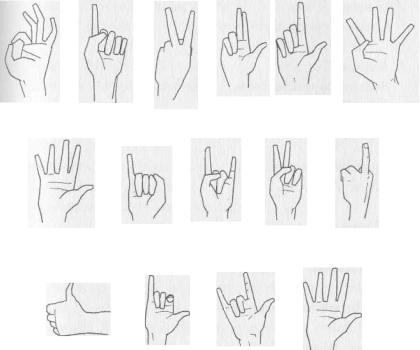
Books on Happiness / The Definitive Book Of Body Language- 2 students
.pdf
Arm Signals
One of the most common versions of creating a subtle barrier is to hold a glass or cup with two hands. You need only one hand to hold a glass but two hands allows the insecure person form an almost unnoticeable arm barrier. These types of gestures are used by almost everyone and few of us are aware
that we're doing them.
Flower grasping shows self-consciousness
The Coffee Cup Barrier
Offering a refreshment during a negotiation is an excellent strategy for gauging how the other person is receiving your offer. Where a person places their cup immediately after they take a drink is a strong indicator of whether or not they are convinced or open to what you are saying. Someone who is reeling hesitant, unsure or negative about what they are hearing will place their cup to the opposite side of their body to form a single arm barrier. "When they are accepting of what they are hearing they place the cup to the side of their body showing an open or accepting attitude.
The arm barrier says 'no' |
She's now open to your ideas |
03
The Definitive Book of Body Language
Sitting with your elbows on the armrest of a chair is a position of power and conveys a strong, upright image. Humble defeated individuals let the arms drop inside the arms of the chair, so avoid this at all times unless your goal is to appear defeated.
The Power ofTouch
Touching a person with your left hand while shaking hands with your right hand can create a powerful result.
Researchers at the University of Minnesota conducted an experiment that became known as 'The Phone Booth Test'. They placed a coin on the ledge of a telephone booth then hid behind a tree and waited for an unsuspecting subject to walk in and find it. When this happened, one of the researchers would approach the subject and say, 'Did you happen to see my coin in that phone booth? I need it to make another call.' Only 23% of the subjects admitted they had found it and gave it back.
In the second part of the study, the coin was again placed in the phone booth but when the researchers approached the people who took it, they touched them lightly on the elbow for not longer than three seconds and inquired about the coin. This time, 68% admitted to having the coin, looked embarrassed and said things like, 'I was looking around to try to see who owned it...'
Skilful elbow-touching can give you up to three times the chance of getting what you want
There are three reasons this technique works: first, the elbow is considered a public space and is far away from intimate parts of the body; second, touching a stranger is not considered acceptable in most countries so it creates an impression; and third, a light, three-second elbow touch creates a momen-
104
Arm Signals
tary bond between two people. When we replicated this experiment for a television programme, we found the coin return rate varied from culture to culture depending on what the normal touch frequency was in a particular place. For example, with elbow touching, the coin was returned by 72% of Australians, 70% of English, 85% of Germans, 50% of French and 22% of Italians. This result shows how the elbow touch works better in places where frequent touching is not the cultural norm. We have recorded the touch frequencies between people in outdoor cafes in many of the countries we regularly visit and noted 220 touches an hour in Rome, 142 per hour in Paris, 25 touches an hour in Sydney, 4 per hour in New York and 0 per hour in London. This confirms that the more British or German your heritage, the less likely you are to touch others and, therefore, the more successful an elbow touch will be on you.
If you're of German or British origin, you're an easier touch than everyone else.
Overall, we found that women were four times more likely to touch another woman than was a man to touch another man. In many places, touching a stranger above or below the elbow did not produce the same positive results as with directly touching the elbow and often received negative reactions. Touching for more than three seconds also received a negative response, with the person suddenly looking down at your hand to see what you are doing.
Touch their Hand Too
Another study involved librarians who, as they issued a book to a borrower, lightly brushed the hand of the person borrowing the book. Outside the library, the borrowers were surveyed and asked questions about their impressions of the service the
105
The Definitive Book of Body Language
library offered. Those who had been touched responded more favourably to all questions asked and were more likely to recall the name of the librarian. Studies conducted in British super, markets where customers are lightly touched on the hand when they received their change show similar positive customer reactions. The same experiment has also been conducted in the USA with waitresses who derive much of their income from customer tips. The elbow-and-hand touching waitresses made 36% more tips from male diners than non-touching waitresses and male waiters increased their earnings by 22% regardless of which sex they touched.
When you next meet someone new and you shake hands, extend your left arm, give a light touch on their elbow or hand as you shake, repeat their name to confirm you heard it correctly, and watch their reaction. Not only does it make that person feel important, it lets you remember their name through repetition.
Elbow-and hand-touching — when done discreetly - grabs attention, reinforces a comment, underlines a concept, increases your influence over others, makes you more memorable and creates positive impressions on everyone.
Summary
It makes no difference how you look at it, any crossing of the arms in front of the body is seen as negative and the message is as much in the mind of the receiver as the sender. Even if you fold your arms because, for example, you have a backache, an observer will still unconsciously perceive you as closed to their ideas. Make a decision now to practise not crossing your arms and in the following chapters we will show you what to do to project a more positive, confident image.
106

Chapter 5
CULTURAL DIFFERENCES
How would a Brit, a German or an
American interpret this gesture?
Imagine this scene - you are inspecting a house with the possibility of purchasing it and you open a bathroom door to see a woman sitting naked in a bathtub. How would you expect the surprised woman to react? A British or American woman would cover her breasts with one hand and her genitals with the other, while a Swedish woman would cover only her genitals. A Muslim woman would cover her face, a Sumatran woman would cover her knees and a Samoan only her navel.
We Were Having Pizza at the Time
As we are writing this chapter, we are in Venice, Italy speaking at a conference on cultural differences. If we had never travelled to Italy, we would have been shocked by what we'd experienced. Allcultures walk on the same side of the pavement as they drive on the road. This means if you're British, Australian, South African or a New Zealander, you drive and walk to the left. The consequence is that you'd find the Italians constantly bumping into you as you walk on the pavement because, as they approach
107
The Definitive Book of Body Language
and you step to your left, they step to their right. Wearing sunglasses in foreign countries is the single biggest cause of pavement collisions between cultures because no one can see the other person's gaze to know which way they intend to step. But it's a novel way of meeting new and interesting foreigners.
You'd also be stunned when you go to shake hands to say goodbye to an Italian but, instead, you get a kiss on both cheeks.
As I departed, the Italian man kissed me on both cheeks. I was tying my shoelaces at the time.
WOODYALLEN
As you talk with local Italians, they seem to stand in your space, continually grabbing you, talking over the top of you, yelling in fact, and sounding angry about everything. But these things are a normal part of everyday friendly Italian communication. Not all things in all cultures mean the same things.
Take the Cultural Test
How aware are you of cultural differences in body language? Try this exercise — hold up your main hand to display the number five - do it now. Now change it to the number two. If you're Anglo-Saxon, there's a 96% chance you'll be holding up your middle and index fingers. If you're European, there's a 94% chance you'll be holding up your thumb and index finger. Europeans start counting with the number one on the thumb, two on the index finger, three on the middle finger, and so on. Anglo-Saxons count number one on the index finger, two on the middle finger and finish with five on the thumb.
Now look at the following hand signals and see how many different meanings you can assign to each one. For each correct answer, score one point and deduct one point for an incorrect answer. The answers are listed at the bottom of the page.
108

Cultural Differences
A B C D E F
G H I J K
L M N O
For each correct answer you got, allocate yourself one point.
A. Europe and North America: OK
Mediterranean region, Russia, Brazil, Turkey:
An orifice signal; sexual insult; gay man
Tunisia, France, Belgium: Zero; worthless
Japan: Money; coins
B.Western countries: One; Excuse me!; As God is my witness; No! (to children)
C.Britain, Australia, New Zealand, Malta: Up yours! USA: Two
Germany: Victory France: Peace
Ancient Rome: Julius Caesar ordering five beers
109
The Definitive Book of Body Language
D. Europe: Three
Catholic countries: A blessing
E. Europe: Two
Britain, Australia, New Zealand: One
USA: Waiter!
Japan: An insult
F.Western countries: Four Japan: An insult
G.Western countries: Number 5 Everywhere: Stop!
Greece and Turkey: Go to hell!
H.Mediterranean: Small penis
Bali: Bad
Japan: Woman
South America: Thin
France: You can't fool me!
I.Mediterranean: Your wife is being unfaithful
Malta and Italy: Protection against the Evil Eye (when pointed)
South America: Protection against bad luck (when rotated) USA: Texas University Logo, Texas Longhorn Football Team
J.Greece Go to Hell! The West: Two
K.Ancient Rome: Up yours!
USA: Sit on this! Screw you!
L.Europe: One
Australia: Sit on this! (upward jerk)
Widespread: Hitchhike; Good; OK
110
Cultural Differences
Greece: Up yours! (thrust forward)
Japan: Man; five
M..Hawaii: 'Hang loose'
Holland: Do you want a drink?
N.. USA: I love you
O.The West: Ten; I surrender Greece: Up Yours — twice! Widespread: I'm telling the truth
What did you score?
Over 30 points: You are a well-travelled, well-rounded, broad-thinking person who gets on well with everyone regardless of where they are from. People love you.
15-30 points: You have a basic awareness that others behave differently to you and, with dedicated practice, you can improve the understanding you currently have.
15 points or less: You think everyone thinks like you do. You should never be issued a passport or even be allowed out of the house. You have little concept that the rest of the world is different to you and you think that it's always the same time and season all over the world. You are probably an American.
Why We're All Becoming American
Due to the wide distribution of American television and movies, the younger generations of all cultures are developing a generic form of North American body language. For example, Australians in their sixties will identify the British Two-Fingers-Up gesture as an insult whereas an Australian teenager is more likely to read it as the number two and will recognisethe American Middle-Finger-Raised as a main form
insult. Most countries now recognise the Ring gesture as meaning 'OK', even if it's not traditionally used locally. Young
111
The Definitive Book of Body Language
children in every country that has television now wear baseball caps backwards and shout 'Hasta la vista, baby', even if the don't understand Spanish.
American television is the prime reason cultural body language differences are disappearing.
The word 'toilet' is also slowly disappearing from the English language because North Americans, who are rugged pioneers and log splitters, are terrified to say it. North Americans will ask for the 'bathroom', which, in many parts of Europe, contains a bath. Or they ask for a 'rest room' and are taken to where there are lounge seats to relax. In England, a 'powder room' contains a mirror and washbasin, a 'little girls' room' is found in a kindergarten and 'comfort stations' are positioned on the motorways of Europe. And a North American who asks to 'wash up' is likely to be gleefully led to the kitchen, given a tea towel and invited to wash the dishes.
Cultural Basics are the Same Almost Everywhere
As discussed in Chapter 3, facial expressions and smiles register the same meanings to people almost everywhere. Paul Ekman of the University of California, San Francisco, showed photographs of the emotions of happiness, anger, fear, sadness, disgust and surprise to people in 21 different cultures and found that in every case, the majority in each country agreed about the pictures that showed happiness, sadness and disgust. There was agreement by the majority in 20 out of the 21 countries for the surprise expressions, for fear on 19 out of 21 agreed and for anger, 18 out of 21 agreed. The only significant cultural difference was with the Japanese who described the fear photograph as surprise.
Ekman also went to New Guinea to study the South Fore
112
